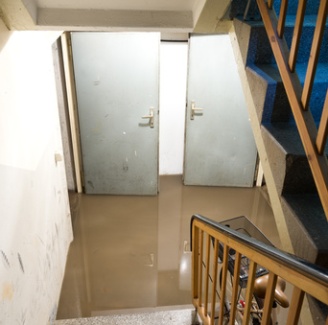Find a Mold Specialist Now
Click or Call, Toll-Free 24/7
cleaning up water damage
Cleaning up water damage can be a huge job. It's important to tackle the job as soon as possible and to do it correctly, because otherwise you can end up with a serious mold problem in your home. Mold can begin to grow in as little as 24 hours. Depending upon the cause of the water damage, bacteria and other health hazards may also be present in your home until the water is cleaned up.
We recommend calling in a water damage contractor for assistance, or at least for some advice, so you make sure your home is a safe and healthful place for you and your family. However, we'll provide you with some basic information about the cleanup process for different types of water damage.
If your home has been flooded or suffered severe water damage, you should call your insurance carrier. Your homeowners insurance policy may cover some or all of the cost of the cleanup and repair.
 Flooded Basement
Flooded BasementFloors
Water damaged floor coverings, such as carpet or linoleum, will need to be removed. In some instances, they can be cleaned and put back down, while in other cases the damage is too great and they will need to discarded and replaced. Make certain that both the floor covering and the subfloor are completely dry before replacing the floor covering. You can read more about dealing with water damage to floors, and specifically hardwood floors or laminate flooring.
Walls
Drywall and insulation that has suffered water damage must be dried within 24 hours, or mold could start to grow. Once it has mold it will need to be removed and replaced. If it was flooded with contaminated water, it will need to be replaced.
Electrical Wiring
If electrical wiring within the walls has been affected by flooding, the electrical system to the home should be shut off until it can be inspected by an electrician. Unless you're an experienced electrician, you should not attempt to clean or repair the electrical system yourself. Doing so is dangerous and could be deadly.
Ceilings
Drywall ceilings or ceiling panels that have suffered water damage must be dried within 24 hours or mold could start to grow. Once they have mold, they must be thrown away and replaced. You can read more about cleaning up water damage to ceilings here.
This article discusses how to deal with a roof leak.
Furniture and Other Household Items
Nonporous items like glass or china dishes, metal pots and pans, and flatware can be cleaned and dried easily. If they develop mold, it can be removed with a household cleaner. Porous items like mattresses and upholstered furniture such as sofas must be dried within 24 hours or mold can develop. Once they have mold, they must be discarded. If they were flooded with contaminated water, they usually need to be thrown away. Rugs, linens, and similar items that can be washed in hot water and dried in a clothes dryer can often be salvaged. Consult a water damage restoration service if you aren't sure whether a particular item can be cleaned or if you aren't sure how to clean it.
Electronics may or may not be able to be salvaged, depending on the extent of the damage. Professional cleaning is recommended and you should not turn on any electric appliance until a professional has cleaned it and given the okay.
Cleaning up Water Damage after a Flood
If your home has been flooded, we suggest calling in a professional to assist, as does the U.S. Environmental Protection Agency (EPA). The water damage will likely be significant, as is the risk of mold developing in the home after a flood. There may also be bacteria or other health hazards present in a home that has been flooded. To protect the health and safety of your family, professional assistance is strongly recommended. If you have flood insurance, your policy should cover the cost.
Note that a home that has been mostly or totally underwater may have structural damage and should be inspected by a professional before you enter the building to begin the cleanup process.
Pumping Water out of the Basement
If your home has flooded and the basement is full of water, the water must be pumped out. The water must be pumped out gradually though, no more than two or three feet per day, or else the pressure outside the basement walls will rapidly become too much greater than the pressure inside the walls, causing the walls, floor, and ceiling to crack or even collapse. Again, if you have flood insurance, your policy should cover the cost.
Consulting a Water Damage Contractor
If your home has been flooded, you should definitely consult a water damage restoration contractor, but you may benefit from some professional advice or assistance even with small jobs. If your homeowners insurance policy will cover the cost of water damage restoration, the contractor can assist you in documenting the damage and filing your claim. To find experienced water damage contractors in your area, just follow the link.
Additional Reading:
Renters Flood Insurance - Why it is important for renters to have flood insurance. Benefits, what is covered.
Refrigerator Leaks - A small leak from your refrigerator can cause a large mold issue.
Return From Cleaning Up Water Damage To Home Page
Ref:
Flood Cleanup
Privacy Policy Terms and Conditions Accessibility Do Not Sell My Information Disclaimer Contact Us




